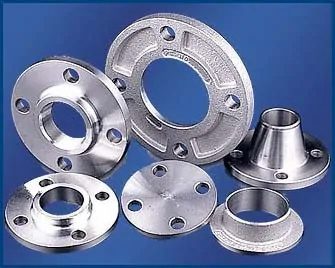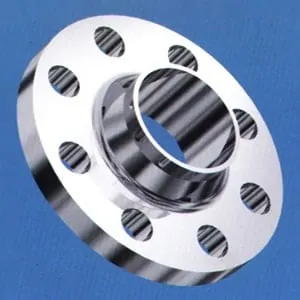Stainless steel flanges are vital components in various industries, serving as connectors for pipes, valves, and other machinery. They play an important role in ensuring smooth operations and facilitating easy access for maintenance and inspections. However, in heavy industries, selecting the appropriate flanges is essential, as they can become potential weak links in the system.
Image Source: Texas Flange
The Importance of Stainless Steel Flanges
Stainless steel flanges are valued for several reasons:
1. Resistance to Corrosion
Corrosion is a significant concern in metal applications. Metals can deteriorate due to rust, chemical reactions, and environmental factors. Stainless steel flanges are chosen for their corrosion resistance.
2. Durability
Stainless steel is known for its durability and ability to withstand high pressure, making it a reliable choice in industrial settings.
3. Withstanding High Temperatures
Industries often operate under extreme temperatures, and stainless steel flanges can maintain their integrity without warping or bending.
Types of Stainless Steel Flanges
Image Source: Texas Flange
Various types of stainless steel flange fittings are designed to serve specific purposes:
1. Weld Neck Flanges
These feature a protruding neck and are suited for high-pressure conditions.
2. Threaded Flanges
Used in special applications where welding is not required.
3. Slip-On Flanges
Cost-effective and easy to install, but not suitable for high-pressure applications.
4. Lap Joint Flanges
Used in conjunction with stub end fittings, it is ideal for systems that require regular inspection.
5. Socket Weld Flanges
Durable and suitable for small-diameter, high-pressure pipes.
6. Ring-Type Joint Flanges
Capable of withstanding high pressure and preventing leaks in pipelines.
7. Orifice Flanges
Used for precise metering of liquids or gases.
8. Blind Pipe Flanges
Seal piping systems or vessels and must endure high internal pressure.
Key Considerations for Choosing Stainless Steel Flange Fittings
Image Source: Texas Flange
Selecting the right stainless steel flange fittings requires careful thought.
1. Fluid Type
Consider the type of fluid being transported, along with its temperature and pressure requirements.
2. Integrity
For pipelines carrying hazardous fluids, prioritize flanges that prevent leaks to avoid environmental risks.
3. Risk of Contamination
In cases where sensitive fluids are transported, ensure that flanges do not contaminate the conveyed fluids.
4. Compliance with Regulations
Ensure that the chosen flanges meet local regulations and industry standards to avoid legal issues.
FAQs (Frequently Asked Questions):
Q1: Why is corrosion resistance crucial in stainless steel flanges?
A1: Corrosion resistance is vital to ensuring the longevity and reliability of industrial systems. Stainless steel flanges are resistant to corrosion, preventing deterioration due to rust and chemicals.
Q2: How durable are stainless steel flanges compared to other materials?
A2: Stainless steel flanges are renowned for their durability and are capable of withstanding high-pressure conditions, making them a reliable choice in industrial settings.
Q3: Can stainless steel flanges endure extreme temperatures?
A3: Yes, stainless steel flanges maintain their integrity without warping or bending, even under extreme temperature conditions, ensuring the system’s reliability.
Q4: When should weld neck flanges be used?
A4: Weld neck flanges are ideal for high-pressure conditions, thanks to their protruding neck design.
Q5: What are the applications of threaded flanges?
A5: Threaded flanges are used in special applications where welding is not necessary.
Q6: Are slip-on flanges suitable for high-pressure applications?
A6: Slip-on flanges are cost-effective and easy to install but not recommended for high-pressure conditions.
Q7: In which systems are lap joint flanges commonly used?
A7: Lap joint flanges work well in systems requiring regular inspection and maintenance.
Q8: What are the advantages of socket weld flanges?
A8: Socket weld flanges are durable and suitable for small-diameter, high-pressure pipes.
Q9: What sets ring-type joint flanges apart?
A9: Ring-type joint flanges are designed to withstand high pressure and prevent leaks in pipelines.
Q10: Where are orifice flanges typically used?
A10: Orifice flanges are used for precise metering of liquids or gases in various industrial applications.
Q11: What is the primary purpose of blind pipe flanges?
A11: Blind pipe flanges are used to seal piping systems or vessels and must endure high internal pressure.
Q12: How does the type of fluid impact flange selection?
A12: The fluid’s type, temperature, and pressure dictate the appropriate flange to ensure long-term performance.
Q13: Why is integrity crucial when selecting flanges?
A13: For pipelines carrying hazardous fluids, flanges that prevent leaks are essential to avoid environmental risks.
Q14: When is the risk of fluid contamination a concern?
A14: In cases where sensitive fluids are transported, it’s crucial to ensure that flanges do not contaminate the conveyed fluids.
Q15: Why is compliance with regulations important in flange selection?
A15: Adhering to local regulations and industry standards is crucial to avoid legal issues and ensure safe operations.
In industrial systems, joints and weld fittings often pose potential weak points. Therefore, selecting the appropriate grade of stainless steel flange fittings is paramount. The reliability and longevity of industrial systems depend on these essential components.
For further information and expert insights on Stainless Steel Flanges and related topics, feel free to explore our website:https://www.texasflange.com/


